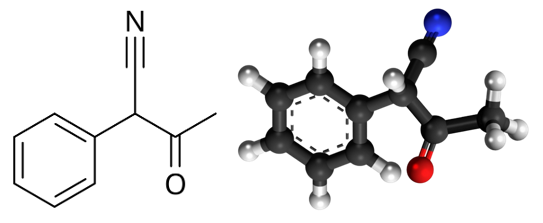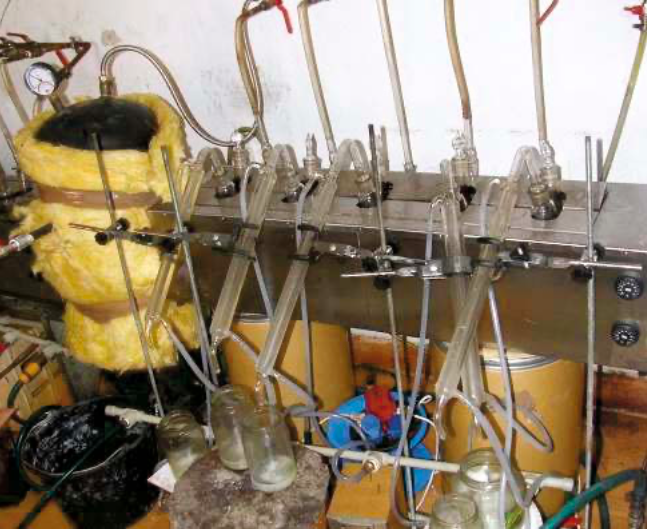- The process of creating a drug - May 23, 2023
- How do scientists model mental disorders in animals? - May 23, 2023
Introduction
alfa-Fenylacetoacetonitril (APAAN), acetylphenylacetonitrile, CAS 4468-48-8 is an organic compound for pharmaceuticals, agrochemicals and fine chemicals. Its chemical structure, comprising a phenyl group attached to an acetoacetonitrile moiety, provides a combination of reactivity and stability. Over the years, phenylacetoacetonitrile has gained notoriety as a precursor to produce phenylacetone, precursor for phenylethylamines.
The importance of the compound in chemistry is due to its functional groups – nitrile and ketone. The nitrile group, for example, is capable of undergoing hydrolysis, while the ketone group can participate in aldol condensations. It is a relatively stable compound under standard laboratory conditions, making it easy to handle and store in both small research environments and large industrial settings.
Many governments have classified phenylacetoacetonitrile as a controlled substance or a precursor chemical, subjecting it to strict regulations.
This article reviews its properties, the synthetic methods used to prepare it, the range of reactions it undergoes, and its various applications in various industries.

Physical and Chemical Properties of Phenylacetoacetonitrile (APAAN)
Phenylacetoacetonitrile (APAAN), CAS 4468-48-8 is an organic compound with the molecular formula C10H9NO. This compound is characterized by the presence of a phenyl group attached to an acetonitrile moiety. Physically, phenylacetoacetonitrile is a white to light yellow crystalline solid with a melting point 92°C. Its molecular weight is 159.18 g/mol, and it has a density of around 1.1 g/cm³. This compound is relatively soluble in organic solvents such as ethanol 15 mg/ml, DMSO 25 mg/ml, methanol, and acetone, but has limited solubility in water.
Chemically, phenylacetoacetonitrile (APAAN) exhibits reactivity typical of compounds with both nitrile and ketone functional groups. The nitrile group can undergo hydrolysis to form carboxylic acids or amides under acidic or basic conditions. The ketone group adjacent to the nitrile group in phenylacetoacetonitrile allows for various reactions such as alkylation and condensation.
Synthesis of Phenylacetoacetonitrile (APAAN)
Phenylacetoacetonitrile (APAAN), CAS 4468-48-8 is an important intermediate in organic synthesis and can be synthesized through various methods.
Alkylation of Benzyl Cyanide with Ethyl Acetate
The most commonly method for synthesizing phenylacetoacetonitrile involves the alkylation of benzyl cyanide with ethyl acetate in the presence of catalyst. Sodium amide is typically used as the catalyst, which facilitates the deprotonation of benzyl cyanide, generating a nucleophilic anion that then attacks the carbonyl carbon of ethyl acetate. The reaction proceeds under controlled temperatures, reflux for two hours and after at 20°C, to ensure optimal conditions for nucleophilic addition and to prevent side reactions.

Alkylation of Benzyl Cyanide with Acetic Anhydride
Another method for synthesizing phenylacetoacetonitrile involves the alkylation of benzyl cyanide with acetic anhydride. In this method, benzyl cyanide is reacted with acetic anhydride in the presence of a catalyst such as sodium ethoxide.


Chemical Reactions of Phenylacetoacetonitrile (APAAN)
Phenylacetoacetonitrile, CAS 4468-48-8 can be used in various chemical reactions, the main ones are listed here.
Phenylacetoacetonitrile can be converted to phenylacetone with strong acid such as phosphoric acid, sulphuric acid or hydrochloric acid. An external heating is also needed to some reaction ways. Synthesis products are phenylacetone, ammonium salt, carbon dioxide, some remaining acid and water.
Phenylacetoacetonitrile to phenylacetone conversion, is a hydrolysis reaction. This is a reaction with water that can be carried out using an phosphoric acid. The reaction has several stages. For example, cyano group is converted into acid group. Decarboxylation takes place in the following reaction stage. Carbon dioxide is formed out from acid group. The reaction mixture boiling point is 100 °C.

Phenylacetoacetonitrile reacts with formamide, undergoing a condensation reaction that results in the formation of 2-phenyl-2-butenenitrile. This reaction is facilitated by heating the mixture.


Applications of Phenylacetoacetonitrile (APAAN)
Phenylacetoacetonitrile, CAS 4468-48-8 is an intermediate in organic synthesis used in a variety of industries due to its reactivity. Its applications span pharmaceuticals, agrochemistry, and fine chemical synthesis, where it serves as a building block for molecules.
1. In the pharmaceutical industry, phenylacetoacetonitrile is used as a precursor in the synthesis of various pharmaceutical ingredients. Phenylacetoacetonitrile is used in the synthesis of non-steroidal anti-inflammatory drugs (NSAIDs), where it can be converted to intermediates such as 2-arylpropionic acids. These acids form the backbone of many NSAIDs, including ibuprofen.
2. In the agrochemical industry, phenylacetoacetonitrile can be used as a precursor in the synthesis of various herbicides, insecticides, and fungicides. For example: Phenylacetoacetonitrile is a starting material in the synthesis of some pyrethroid insecticides, which are widely used to control agricultural pests.
3. Synthesis of fine chemicals in addition to pharmaceuticals and agrochemicals, phenylacetoacetonitrile is also used in the synthesis of dyes and special materials. Phenylacetoacetonitrile can be used as an intermediate in the synthesis of azo dyes .

Health Effects of Phenylacetoacetonitrile (APAAN)
Phenylacetoacetonitrile, CAS 4468-48-8 is a compound that poses several health risks if proper precautions are not taken. Phenylacetoacetonitrile can affect health through several routes of exposure: inhalation, skin contact, eye contact, and ingestion.
• Inhalation: When phenylacetoacetonitrile is handled in powder form it can become airborne and be inhaled. Inhalation of its dust can irritate the respiratory system, which can lead to coughing, difficulty breathing, or even respiratory distress if exposure is significant.
• Skin Contact: Direct skin contact with phenylacetoacetonitrile can cause irritation. This compound can penetrate the skin, causing local effects such as redness, itching, or more severe dermatological reactions, especially with prolonged exposure.
• Eye Contact: If phenylacetoacetonitrile comes into contact with the eyes, it can cause severe irritation. Symptoms may include redness, pain, tearing, and blurred vision. In extreme cases, exposure can cause more serious eye damage if not treated promptly.
• Ingestion: Accidental ingestion of phenylacetoacetonitrile, although less common in laboratory settings, can be particularly dangerous. Ingestion can result in gastrointestinal irritation, nausea, vomiting, and more serious systemic effects due to its toxic nature.
• Chronic symptoms: Repeated or prolonged exposure to phenylacetoacetonitrile may lead to more serious health problems. Chronic inhalation may potentially lead to permanent respiratory problems, including chronic bronchitis or asthma-like symptoms. Long-term skin exposure may lead to sensitization, causing allergic reactions upon subsequent exposures. Repeated ingestion, although unlikely in a controlled laboratory environment, may cause systemic toxicity affecting multiple organs.
Safety Precautions
Phenylacetoacetonitrile, CAS 4468-48-8 like many organic chemicals, must be handled with care in the laboratory to ensure the safety of personnel and the environment. Appropriate personal protective equipment must be used when handling phenylacetoacetonitrile.
• Gloves: Nitrile gloves should be worn to prevent skin contact.
• Lab Coat: A lab coat should be worn to protect against accidental spills and to protect clothing from contamination.
• Eye Protection: Safety goggles or face shields should be used to protect the eyes from splashes or aerosols that may cause significant irritation or damage.
• Respiratory Protection: In situations where phenylacetoacetonitrile is handled in large quantities or where ventilation is inadequate, a cartridge respirator should be used to prevent inhalation of vapors or dust.
• Ventilation: Always handle phenylacetoacetonitrile in a well-ventilated area, preferably under a fume hood. This helps prevent a build-up of vapors that may be harmful if inhaled.
• Minimize exposure: Avoid direct contact with phenylacetoacetonitrile by using appropriate tools such as spatulas, pipettes, and dispensers. Never touch the compound with bare hands.
Phenylacetoacetonitrile storage:
• Temperature and Environment: Store phenylacetoacetonitrile in a cool, dry place, away from direct sunlight and heat sources. The compound should be stored in a container to prevent moisture from entering, which can lead to hydrolysis and the formation of potentially dangerous by-products.
• Separation: Phenylacetoacetonitrile should be stored separately from incompatible substances such as strong acids, bases, and oxidizing agents that can cause dangerous reactions.
Conclusion
Phenylacetoacetonitrile, CAS 4468-48-8 is an important intermediate in organic syntheses, particularly phenylethylamines. Its nitrile and ketone functional groups provide the basis for chemical reactions, allowing the synthesis of complex organic molecules. As the demand for effective chemical intermediates continues to grow, phenylacetoacetonitrile is in demand in manufacturing and laboratories.
Bibliography
- BMK (benzylmethylketone) synthesis from APAAN (a-phenylacetoacetonitrile). Large scale. https://bbgate.com/threads/bmk-benzylmethylketone-synthesis-from-apaan-a-phenylacetoacetonitrile-large-scale.57/
- Synthesis of APAAN (a-phenylacetoacetonitrile) with sodium amide (1kg scale) https://bbgate.com/threads/synthesis-of-apaan-a-phenylacetoacetonitrile-with-sodium-amide-1kg-scale.60/
- C-Alkylation of active methylene compounds by means of alcohols. VII. Synthesis of .alpha.-substituted phenylacetonitriles from .alpha.-phenylacetoacetonitrile Abe, Nobuhiro Miyano, Seiji The Journal of Organic Chemistry American Chemical Society 1972/02/01 https://doi.org/10.1021/jo00968a054
- Langone D. et al. Impurity profiling of methamphetamine synthesised from α‐phenylacetoacetonitrile (APAAN) //Drug Testing and Analysis. – 2022. – Т. 14. – №. 1. – С. 56-71 https://doi.org/10.1002/dta.3140

